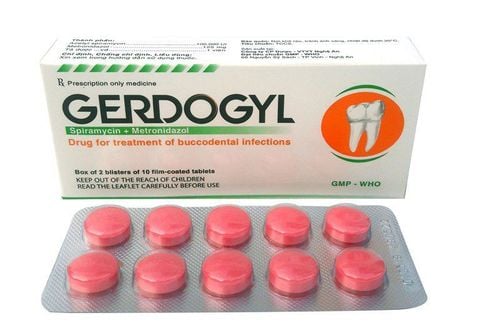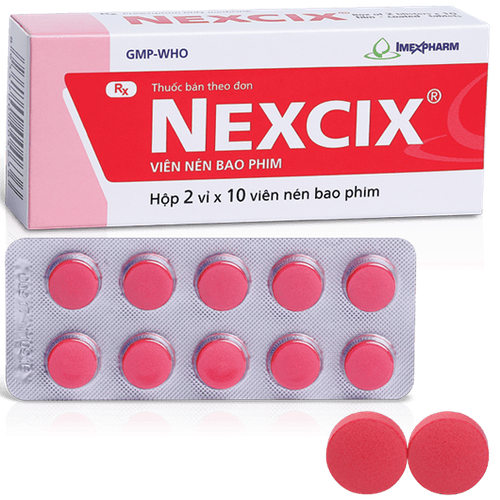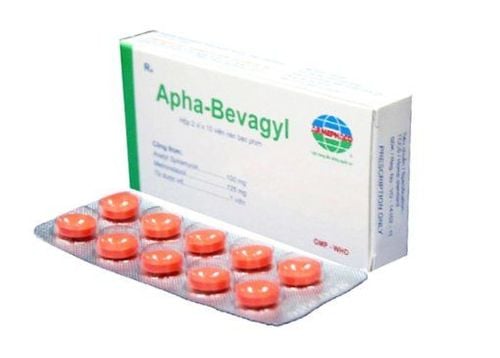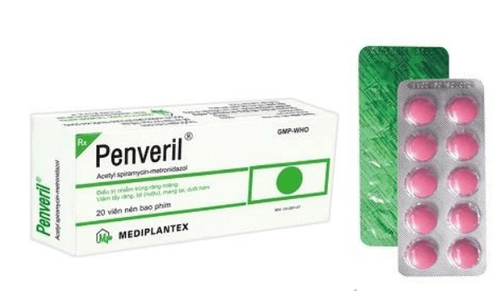This is an automatically translated article.
Grovamix is a combination antibiotic between Metronidazole and Spiramycin. Grovamix is indicated in cases of oral infections, cellulitis around the jawbone, periodontitis, periodontitis, and inflammation of the salivary glands. The following article provides you with information about the uses and notes when using Grovamix.
1. Uses of Grovamix
Grovamix is a combination antibiotic between Metronidazole 75000IU and Spiramycin 125mg. Grovamix is available in the form of tablets.
Spiramycin is an antibiotic belonging to the Macrolide group, the drug has an antibacterial spectrum similar to Clindamycin and Erythromycin. Spiramycin has a bacteriostatic effect on dividing cells at serum concentrations, however, when tissue concentrations are reached, the drug may have a bactericidal effect.
The mechanism of action of Spiramycin is to act on the 50S subunit of bacterial ribosomes and prevent bacterial protein synthesis.
The antibacterial activity of Spiramycin against bacteria that cause dental disease includes:
Bacteria commonly susceptible: Pneumococcal, non-group D streptococcus, meningococcal, Actinomyces, Bordetella pertussis, Corynebacteria, Mycoplasma, Chlamydia. Infrequently susceptible bacteria: Staphylococci, group D streptococci, gonorrhea, Haemophilus influenzae. Resistant bacteria: Gram-negative aerobic bacilli. Metronidazole is a 5-nitro-imidazole derivative with a broad spectrum of activity against protozoa such as Giardia, amoebae and anaerobic bacteria.
The mechanism of action of Metronidazole is unknown. In parasites, the 5-nitro group of the drug is reduced to a cytotoxic intermediate. These substances bind to the helical structure of the DNA molecule, breaking this strand and causing cell death.
Mean effective concentrations of Metronidazole are 8 mcg/ml or less for most susceptible protozoa and bacteria. The minimum inhibitory concentration of susceptible bacteria is about 0.5 mcg/ml. Bacterial isolates are considered susceptible to Metronidazole when the minimum inhibitory concentration does not exceed 16 mcg/ml.
The antibacterial activity of the antibiotic Metronidazole on pathogenic bacteria in the oral cavity includes:
Commonly susceptible bacteria: facultative anaerobic bacilli: Clostridium, Bifidobacterium bifidum, C. perfringens, Bacteroides fragilis, Eubacterium, Melaninogenicus, Fusobacterium, Veillonella, Peptostreptococcus, Pneumosintes, Peptococcus. Infrequently susceptible bacteria: Actinomyces, Propionibacterium acnes, Arachnia. Resistant bacteria: aerobic bacilli, facultative anaerobic bacilli.
2. Indications and contraindications of the drug Grovamix
Grovamix is indicated in the following cases:
Treatment of acute, chronic or recurrent oral infections, especially tooth abscesses. Inflammation, cellulitis around the jawbone, gingivitis, inflammation around the crown, stomatitis, periodontitis, inflammation of the parotid salivary glands, inflammation of the submandibular salivary glands. Prophylaxis of postoperative oral infections. Grovamix is contraindicated for use in the following cases:
Hypersensitivity to Spiramycin, Metronidazole or any other ingredient in Grovamix. Children under 6 years old (due to inappropriate dosage form of the drug).
3. How to take Grovamix
Grovamix is taken orally. Dosage of Grovamix:
Treatment of acute, chronic or recurrent oral infections; inflammation, cellulitis around the jawbone, gingivitis, inflammation around the crown, stomatitis, periodontitis, inflammation of the parotid salivary glands, inflammation of the submandibular salivary glands:
Adults: Dosage 4-6 tablets /day, divided into 2-3 times / day, take the drug with meals. In severe cases, a dose of up to 8 tablets can be used. Children: 6 - 10 years old: Dose 2 tablets/day. Children 10 -15 years old: Dose 3 tablets/day. Prevention of post-operative oral infections:
Adults: Dose 4-6 tablets/day, divided into 2-3 times/day, take medicine with meals. Children: 6 - 10 years old: Dose 2 tablets/day. Children 10 -15 years old: Dose 3 tablets/day. Overdosage of Grovamix and treatment:
Spiramycin: There is no information on overdose of Spiramycin. Gastrointestinal symptoms in overdose may be nausea, vomiting, diarrhea. Metronidazolel: Cases of a single oral dose of up to 15 g have been reported. Overdose symptoms include ataxia, nausea, and vomiting. Neurotoxic effects including convulsions, peripheral neuritis may occur after 5 to 7 days of dosing of 6 - 10.4 g every 2 days. There is currently no specific antidote to Metronidazole. In case of drug overdose, mainly symptomatic and supportive treatment is applied. Metronidazole can be removed from the body by hemodialysis. Missing a dose of Grovamix and what to do:
If you forget to take a dose of Grovamix, take it as soon as possible. If it is almost time for the next dose of Grovamix, skip the missed dose and take the next dose as scheduled. Also, do not double the dose of Grovamix.
4. Undesirable effects of the drug Grovamix
Some undesirable effects when using Grovamix have been reported:
Common:
Nervous: Headache. Gastrointestinal: Indigestion, anorexia, epigastric pain, abdominal pain, nausea, vomiting, diarrhea, constipation, dry mouth, unpleasant metallic taste in the mouth. Uncommon:
Skin: Skin rash, blistering, urticaria. Blood: Agranulocytosis, leukopenia. Central nervous system: Peripheral polyneuropathy, seizures, headache. Urinary: Dark urine. Gastrointestinal: Colitis. Body as a Whole: Fatigue, anaphylactic reactions, superinfection. In case of serious side effects, patients need to stop using Grovamix and go to the nearest medical facility for timely treatment.
5. Notes when using Grovamix
Do not use Spiramycin in patients with glucose-6-phosphate-dehydrogenase deficiency. Patients with a history of hematological disorders, patients on high doses or on long-term treatment with Grovamix, have regular blood tests. Ability to drive and use machines: While taking Grovamix, patients are at risk of dizziness, confusion, hallucinations or convulsions. Do not drive or operate machinery if these symptoms are present. Pregnancy: Spiramycin and Metronidazole both cross the placenta. Therefore, it should not be used in the early stages of pregnancy, in case it is necessary to follow the doctor's prescription. Lactation: Spiramycin and Metronidazole are excreted in breast milk. Grovamix should not be used during lactation.
6. Drug interactions
Spiramycin used concurrently with oral contraceptives will make the contraceptive ineffective. Metronidazole enhances the effect of oral anticoagulants, especially Warfarin, and therefore should not be used concurrently. Phenobarbital: Concomitant administration of metronidazole increases the metabolism of metronidazole. Lithium: Concomitant administration of metronidazole increases serum lithium concentrations which may cause lithium toxicity. Above is all information about Grovamix, patients need to carefully read the instructions for use, consult a doctor / pharmacist before using. Note, Grovamix is a prescription drug, patients need to use the drug as prescribed by the doctor, absolutely do not self-treat at home.













